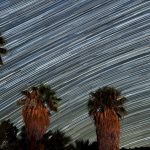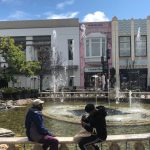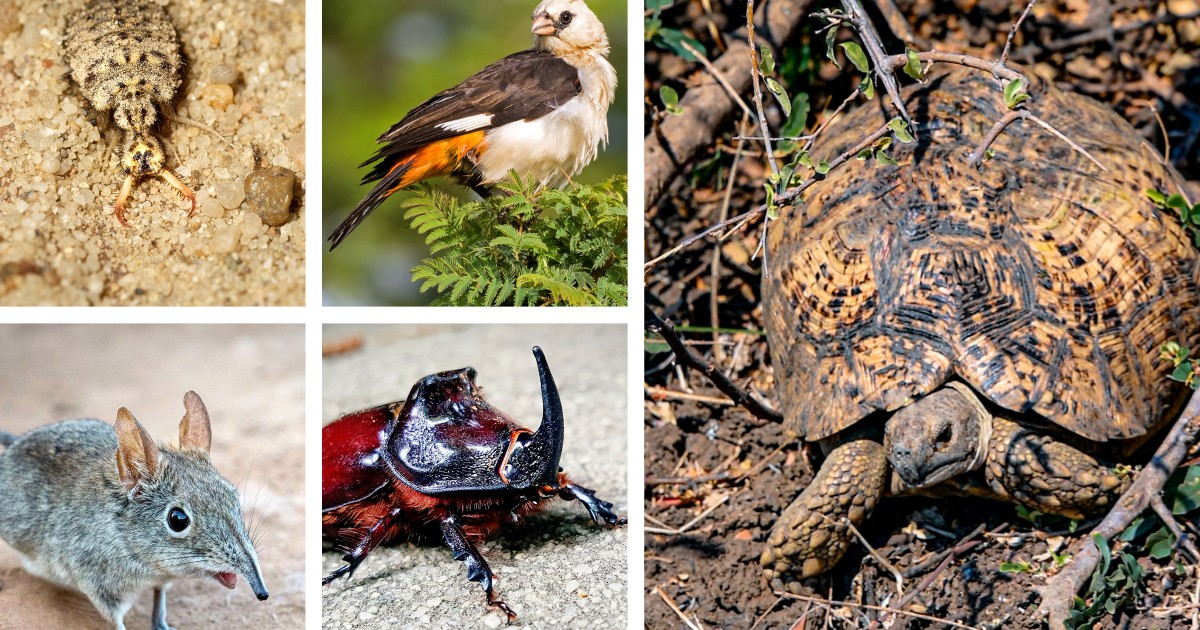
My husband and I ended up hrs into a early morning trek in just one of Zambia’s wildlife-wealthy nationwide parks, and we experienced by now witnessed some marquee safari sights — elephants, baboons, impalas. Then one of our guides stopped small. He pointed forward to a thrilling discovery.
It was an animal that I’d been informed would be tough to spot because it was the dry year. But there it was, peering from beneath a bush: a leopard tortoise, a wonderful reptile with a spotted shell.
Ok, so it was not a single of the Major Five animals safari-goers get enthusiastic about as they whiz by way of the African bush by Land Rover. It was as an alternative some of the smaller sized factors — the “Little Five” birds, bugs and reptiles — that we desired to see by heading on foot. They all have names that echo their significant-time counterparts: ant lion, rhinoceros beetle, buffalo weaver and elephant shrew, as perfectly as the leopard tortoise.
We decided to arrive to Zambia, just one of the less-traveled destinations in Africa, since it is the home of the going for walks safari. The landlocked previous British colony in southern Africa specializes in this way of wandering by wildlife habitat.
It is uncomplicated to view animals up close in a regular vehicle-primarily based safari, but there is a distinct perspective on a going for walks safari.
(Monthly bill Patterson)
We noticed all forms of items we would have skipped from a car or truck: Fluorescent purple bugs. Extravagantly crested birds. A zebra leg, a remnant of a operate-in with a lion. A hippo cranium, allowing for a seem at the lethal jaw inside of that unappealing-cute animal. Paw prints that informed tales about the dimension and practices of animals.
A going for walks safari appealed to me for the reason that I am so restless I could not picture paying 10 times in a Land Rover. A standard driving safari seemed more like wildlife voyeurism than immersion in nature. With the slower speed and depth-oriented target of a going for walks safari, I hoped to realize animals, not just see them.
We traveled in early November at the conclude of the dry time, a fantastic wildlife-viewing time for the reason that animals flock to rivers when drinking water is sparse. We benefited from reduced charges, which fall about Nov. 1 in most destinations. Which is deemed the starting of the rainy year, but it rained only 2 times, towards the finish of our two weeks.
To see a vary of environments, we frequented three national parks — South Luangwa, Decreased Zambezi and Kafue — and stayed in bush camps from rustic to deluxe. One location, Musekese Camp in Kafue, had bucket showers an additional, Sausage Tree Camp in Reduced Zambezi, experienced a masseuse. All furnished all-inclusive companies in breathtaking settings.
The outsiders
We arrived to see that we were encroaching on the animals’ turf. A warthog grazed around our cabin in one particular spot. We would have to detour for foods if elephants were wandering around. After, on returning from a morning walk, we couldn’t arrive at our cabin mainly because a male lion had settled close by for his afternoon siesta.
On a standard day, we rose at 5 a.m. to start off walking even though it was not as well sizzling. We would return to camp for lunch and relaxation in the midday warmth, then head out again in late afternoon for a generate. I much most well-liked the walks, but the different modes of vacation were complementary: You can not see the large animals up near unless you are in a vehicle, and you can’t entirely take pleasure in them right until you get near to their habitat.
It was straightforward to place the Big 5 (other than for the endangered rhinoceros) while driving for the reason that they are unafraid of people today in vehicles. Within just our very first hours on the ground, when staying driven to our initial camp in South Luangwa, we spotted hippos, baboons, zebras, elephants, buffaloes, giraffes and all method of antelopes. It was practically too quick, like using a zoo tour.
It was a diverse tale the future working day on a 4-hour wander that commenced at 6 a.m. We spotted elephants, warthogs and hippos, but they saved their length: Animals are a lot more fearful of folks approaching on foot than in vehicles. That assisted allay my initial fears that heading on foot was recklessly dangerous. (This was the to start with time I’d bought additional overall health insurance for an intercontinental excursion.)
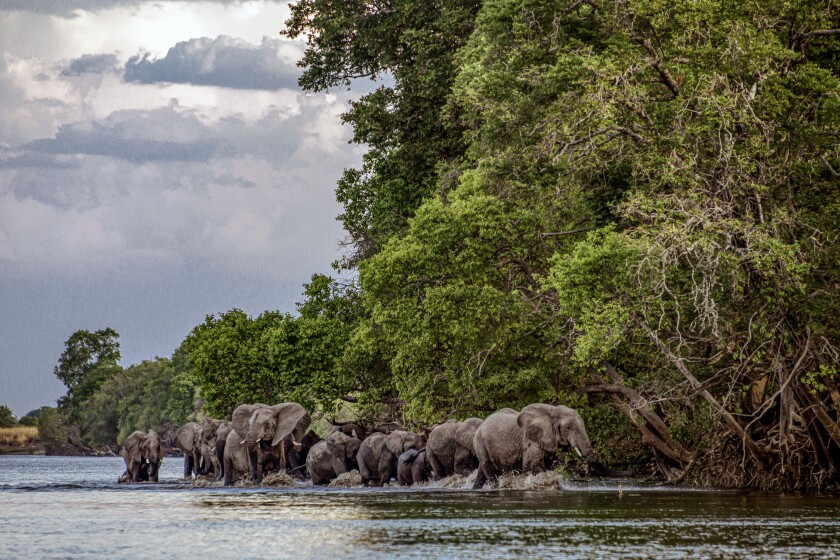
Elephants found from a motor boat on the Kafue River. Traveling by boat supplies a fantastic vantage for wildlife viewing for the duration of the dry year.
(Bill Patterson)
A further safety blanket: We generally hiked with a rifle-toting scout. He walked out entrance, scanning the horizon, heading up hills before us to be sure we did not surprise a herd of elephants or buffalo. But the hazard was reduced: Just one Zambian advised us he had been scouting for 16 yrs and never had to use his gun.
It wasn’t very long prior to we started spotting the “Little Five.” An elephant shrew — a little mammal with a trunk-shaped nose — dashed across the route and into the brush. The lairs of the ant lion — an insect that builds a small, conical sand pit, lurks at the bottom and waits for an ant to tumble down and into its clutches — ended up all over the place.
Termites as helpers?
Our effectively-educated Zambian guides unlocked mysteries of the landscape.
What are those people towering earthen mounds we see all over the put? They ended up crafted by termites, which have a poor rep in civilized culture as a basis-feeding on pest. But in nature, they play an invaluable purpose decomposing dung and wood, and the consequence is mounds that provide as wealthy planting soil. We observed one particular mound with 15 species of trees rising.
Who understood what hippos did at night? We noticed them wallowing in the river during the day, but they graze on land at evening. We uncovered that as we walked alongside their properly-trod paths — hippo highways.

Hippos in the Luangwa River at the conclude of the dry season. Hippos shell out their times in drinking water, but shift on to land at evening to graze.
(Monthly bill Patterson)
How do hippos mark territory? Our guide showed us hippo dung hanging on a bush. They depart their mark by flicking their tails to unfold their dung. Quickly it built perception when we observed that odd actions when males faced off in the river.
We also noticed the magnificent improvements that happen when the dry season gives way to the wet one particular. The first rain in Kafue National Park came close to the close of our check out. Torrential rain and wind battered the canvas walls of the camp, sending the staff members scampering to batten matters down.
We uncovered the landscape was remodeled when we walked the following early morning. New waterways flowed. Shiny purple bugs — velvet mites — arrived out and speckled the floor as they do only soon after it rains. Termites flew out of their mounds, crawled on the floor and were gobbled up by hungry animals. Ants scrambled all over the spot, together with up my leg when I built the error of crossing their paths.
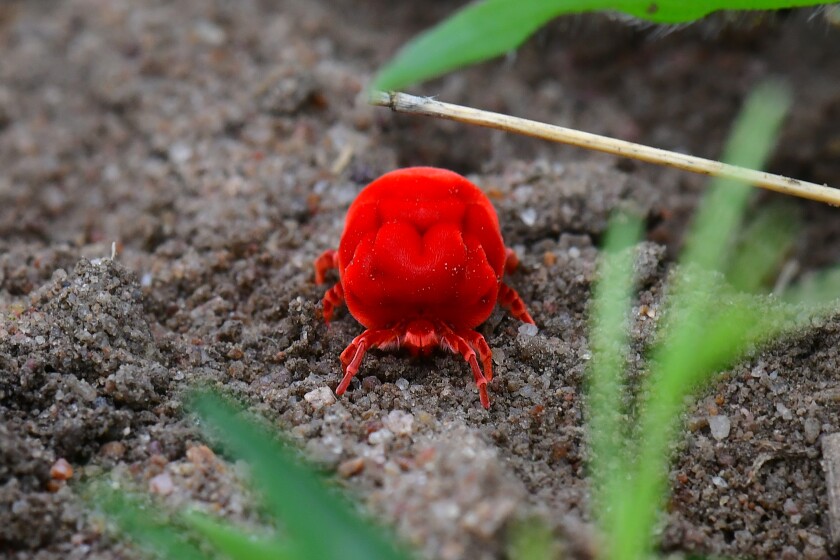
Velvet mites speckled the floor following a rain.
(Getty Images)
That was an uncomfortable reminder that tiny factors in the bush are not only wonderful but also likely dangerous. On our past night time, we dined at Musekese Camp with co-operator Tyrone McKeith he abruptly rose from the table and told me not to transfer. He arrived at above and swatted something from my tummy. Only then did he tell me it was a scorpion.
This journey took us to some of the most remote destinations I’d ever visited, so in some cases it felt as if we had been in a Joseph Conrad novel. To get to Musekese Camp, we flew in a four-seat prop airplane to a dusty airstrip (the pilot had to fly once over the strip to be positive no animals were being in the way). We were picked up in a Land Rover, then transferred for a boat ride, then on to one more Land Rover for a last extend. At the stop was a surprise, but it was barely a “Heart of Darkness” expertise. There have been only two other friends at the camp when we arrived. A person of them was a subscriber to the Los Angeles Moments.
If you go
THE Best WAY TO ZAMBIA
From LAX, Turkish Air, KLM, Emirates and Delta provide connecting assistance (modify of planes) to Zambia’s money, Lusaka. Limited spherical-vacation fares from $1,990, such as taxes and fees.
Flights from Lusaka to little airports around Zambia’s nationwide parks are offered from Proflight Airways (proflight-zambia.com). Charter flights are out there from Sky Trails (skytrailszambia.com). Some camps provide ground transportation from Lusaka or nearby airports.
TELEPHONES
From the U.S., dial 011 (the international dialing code) and 260 (the state code for Zambia). Some camps beneath are managed from South Africa, wherever 27 is the region code.
The place TO Stay
Time + Tide Kakuli, South Luangwa Nationwide Park 27-60-642-4004, bit.ly/kakulicamp. Just one of 10 camps operated in Zambia by Time + Tide. All-inclusive rate (lodging, all meals and beverages, laundry, pursuits) from $730 for every person per evening.
Sausage Tree Camp andPotato Bush Camp, Lower Zambezi National Park 27-76-586-1927, sausagetreecamp.com, potatobushcamp.com. Sausage Tree features luxurious accommodations in a spectacular setting Potato Bush, a sister camp, accommodates households. All-inclusive rate (lodging, all meals and drinks, non-public information, laundry, activities) from $990 for every particular person per night (Sausage) and $650 per man or woman for every night time (Potato).
Musekese Camp, Kafue Nationwide Park 26-09-741-73403 or 26-09-7621-5426, jefferymckeith.com/musekese. A single of the very last proprietor-operate safari camps in Zambia. All-inclusive rate (lodging, all foods and drinks, laundry, things to do) from $560 for every human being per night, minimal time.
TO Learn More
Zambia Tourism, little bit.ly/zambiaparks
Group visits and tailor-designed excursions to Zambia are supplied by:
Audley Vacation, 77 N. Washington St., Boston (855) 838-8300, audleytravel.com/us/zambia
All-natural Environment Safaris, 130A Western Highway, 2nd Flooring, Brighton, England (866)357-6569, little bit.ly/zambiaholidays


